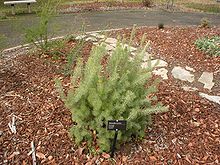Adenanthos sericeus
| Adenanthos sericeus | |
|---|---|
 |
|
| Scientific classification | |
| Kingdom: | Plantae |
| (unranked): | Angiosperms |
| (unranked): | Eudicots |
| Order: | Proteales |
| Family: | Proteaceae |
| Genus: | Adenanthos |
| Species: | A. sericeus |
| Binomial name | |
|
Adenanthos sericeus Labill. |
|
| Subspecies | |
A. sericeus subsp. sericeus
A. sericeus subsp. sphalma
Adenanthos sericeus, commonly known as Woolly Bush, is a shrub native to the south coast of Western Australia. It has bright red but small and obscure flowers, and very soft, deeply divided, hairy leaves.
A, A. sericeus mostly grows as an upright, spreading shrub but occasionally takes the habit of a small tree up to 5 m (16 ft) tall. It has erect branches that are covered in short hairs when young, but these are lost with age. Leaves may be up to 40 mm (1.6 in) long, and repeatedly divide by threes into from 5 to 50 narrow laciniae, circular in cross-section, with a diameter of less than 0.5 mm (0.02 in).
Flowers are red, and occur alone or in small groups, hidden within the foliage at the end of branches. As with most other Proteaceae, each flower is composed of a tubular perianth of four united tepals, ending in a structure called a limb; and a single pistil, the stigma of which is initially trapped inside the limb, but is released at anthesis. In A. sericeus, the perianth is bright red, about 28 mm (1.1 in) long, hairy on the outside but smooth and hairless inside. The style is about 40 mm (1.6 in) long; being much longer than the perianth, it is very sharply bent for as long as the stigma remains trapped within the limb, and then springs erect. The fruit is an oval-shaped achene about 5 mm (0.2 in) long.
This species was first described by Jacques Labillardière in his 1805 Novae Hollandiae Plantarum Specimen, under the name Adenanthos sericea. No explicit etymology for the specific name was given, but it is accepted that it is from the Latin sericeus ("silky"), in reference to the very soft foliage.
...
Wikipedia
